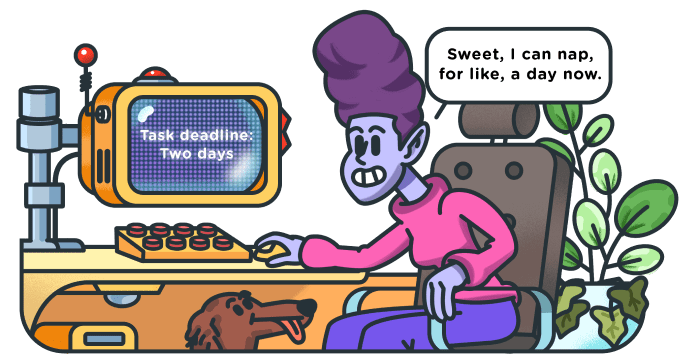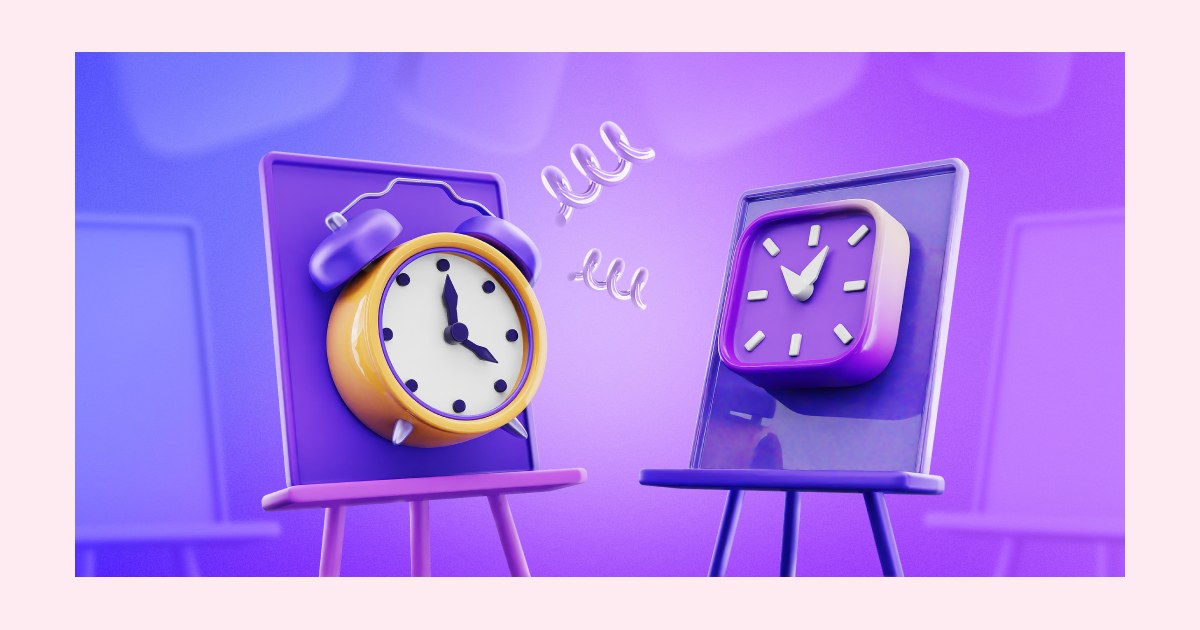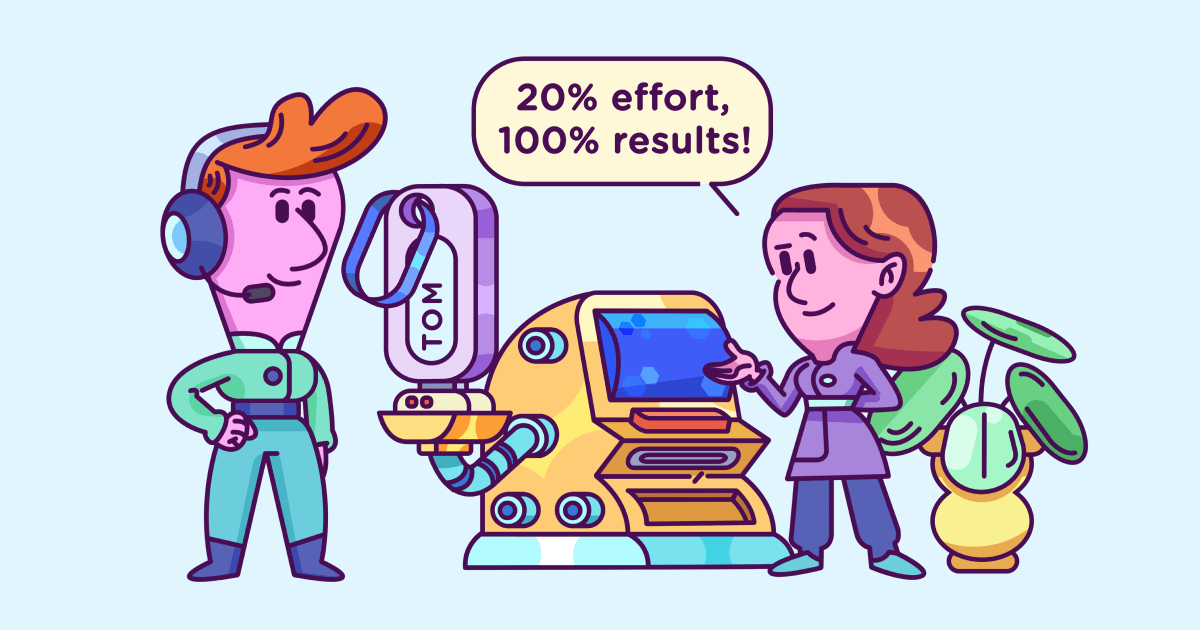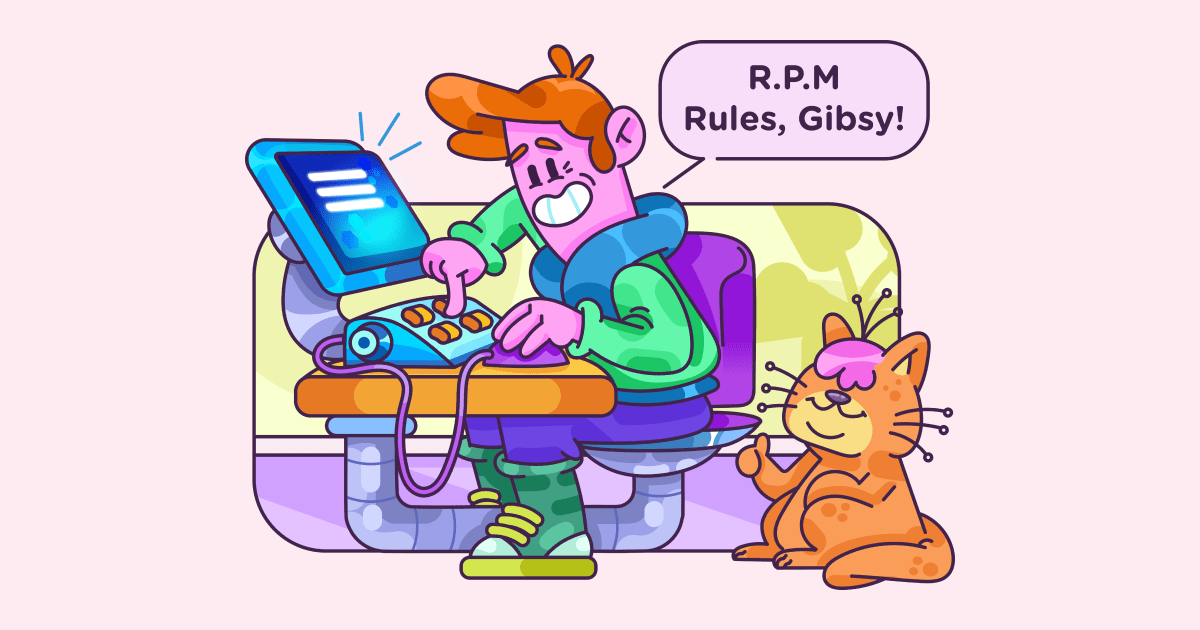Present bias: how to overcome it to pursue your future goals
Last updated on: December 22, 2021
It’s 6 a.m. and you hear your alarm clock buzzing. You’re sleepy and not exactly sure why you have to get up so early. And then, it hits you. You promised yourself you’ll go for a run before work. Oh, but you’re so tucked in, and it’s freezing outside.
What do you do? Do you choose to sleep for another hour or do you jump out of bed straight into your running shoes?
Deciding to sleep in is the choice that provides you with immediate joy, which is the essence of present bias. In this blog post, we’ll tackle this subject and show you the link between present bias and your long-term goals. Moreover, we’ll help you overcome present bias to pursue your future goals.

Table of Contents
The story of present bias or why we always seek immediate rewards
The example we mentioned earlier illustrates how present bias can manifest itself in practice. Let’s dive deeper into the essence of this term by exploring its definition.
What is the present bias?
The present bias, or the hyperbolic discounting, as stated in the article Doing It Now or Later, published by The American Economic Review, “refers to the tendency of people to give stronger weight to payoffs that are closer to the present time when considering trade-offs between two future moments.”
So, simply put, when given an opportunity to choose between a smaller reward this moment and a larger prize in the future, people tend to select the immediate reward. We strive to experience current enjoyment, which usually means postponing more complex tasks for the future. Now, even though we’re aware that demanding activities will move us closer to our goals, present bias keeps us focused on this moment and current gratification. Therefore, we leave significant assignments for the future, which is why hyperbolic discounting can sometimes lead to procrastination.
Present bias examples
Here are some common examples of present bias:
- Using credit cards. Credit cards allow you to purchase a product right now, and pay the following month. Thus, you’ll have an immediate reward of having new shoes, rather than waiting for your next paycheck, when you’ll be able to buy both new shoes and a new bag. So, even though this potential purchase would be a larger award, you want to treat yourself without delay.
- Going out on a workday. Your present self truly enjoys spending time with friends. But, tomorrow morning, your future self will probably regret going to bed at 2 a.m. When you think about it, going out on weekends usually sounds like a better idea, but sometimes we can’t wait several more days. So, we need an immediate reward.
Now, let’s take a look at another example of hyperbolic discounting. The following case proves that we make significantly diverse decisions for the present moment and for our future.
- In the study about making decisions for the future, researchers wanted to find out whether undergraduate students were willing to tutor their peers. According to their findings, students are more likely to help their peers in the near future — for example, during the midterm period, even though it’s a stressful time. So, students’ responses show that they’re able to commit to tutoring in the future (for 85 minutes on average), while they’re less likely to tutor in the present (for 27 minutes on average).
As you can see, present bias can lead to postponing tasks and activities for the future version of ourselves.
Present self vs. future self
How do you imagine yourself in 30 years? When you picture that person in your mind, do you perceive him/her as an older version of yourself or some stranger you barely recognize?
Whether we feel connected with our future self, that’s what researchers at Stanford also wanted to find out. Professor Hal Hershfield presented the results of the study he and his team conducted in one HBR article. The idea behind this research was to examine whether seeing pictures of their older selves (avatars created to resemble participants in the future) would have an impact on decisions participants make about savings.
The next step volunteers had to take was to decide how to allocate $1,000. They had four options:
- buying a present for their special someone,
- investing money in a retirement fund,
- organizing a fun event, or
- investing money in a checking account.
Participants who had a chance to see their elderly avatar were more likely to invest their money into a retirement fund, compared to other groups.
So, once you become aware of the fact that your future self is still you, only a version with gray hair and more wrinkles, you’ll be able to connect with that person. Moreover, maybe you’ll think of your future self the next time you consider starting a savings account.
Present bias and achieving our long-term goals
We already mentioned that present bias leads us to choose immediate small rewards, instead of larger prizes in the future. But, when it comes to achieving your long-term goals, you’ll sometimes have to tackle demanding tasks that won’t make you happy right away but are essential for accomplishing your targets. Thus, hyperbolic discounting can stand in the way of attaining your objectives, which we’ll discuss further in the following section.
Long-term reward or immediate gratification?
How does hyperbolic discounting prevent you from reaching your long-term reward — in this case, your future goals?
Well, present bias can encourage you to make poor decisions because it promotes:
- immediate gratification, and
- impulsiveness.
For example, your long-term goal is to lose weight. As a long-term reward, you’ll feel better about yourself, and you’ll be able to do some activities, such as walking up the stairs, with ease. But, you’ll have a lot to sacrifice to lose weight. On some days, you won’t feel motivated to carry on. And, if you just let present bias guide you, you’ll impulsively decide to have some candy or skip an exercise. Of course, this isn’t a major issue if it happens once, but if you constantly repeat this mistake, you won’t reach your goal of losing weight.
In addition, hyperbolic discounting prevents you from seeing the benefits of long-term decision-making. When you think about it, making long-term decisions provides you with greater gains than short-term ones, such as opting for immediate gratification. For instance, investing money for retirement is a long-term decision. Your future self would surely be able to live comfortably from such savings. But, present bias always places more value on short-term decisions like buying new clothes.
Why do we find it hard to select long-term rewards?
So, thanks to hyperbolic discounting, we focus all our attention on immediate rewards. Why do we ignore long-term gratification?
The certainty effect
We don’t like taking risks, so we prefer pursuing something we’ll certainly manage to obtain. Therefore, instead of waiting longer to get a greater, but sometimes, improbable prize, we select a certain reward now. As the authors of the article Prospect Theory: An Analysis of Decision under Risk claim, that’s called the certainty effect. So, when we have a choice between a sure and a riskier gain, we choose the first option. Even though it can be possible to get a larger reward, we opt for a safe choice.
It’s worth noting that some scientists believe that even our great ancestors had to deal with present bias. Whenever our ancestors found food, they would eat it straight away, even if it was some small animal. Better to eat a smaller animal now than wait for another week or month to find a (potentially) larger one.
We don’t like waiting
Anticipating a greater prize in the future can be difficult. Plus, it takes a lot of self-control and self-discipline to reject an immediate reward and work your way towards a future prize.
So, why does this happen? One explanation is that humans have a non-linear perception of time. Depending on the situation, we feel like time is passing slower or faster.
According to Muireann Irish, a cognitive neuroscientist, our goals and motivation play an important role in time perception. In the radio program All in the Mind, Muireann explains that the emotions we have towards some activities are also crucial:
“So, for example, if you are looking forward to an event, it can seem that the time is dragging and that it can’t get here quickly enough. If you are not looking forward to something and you have a negative appraisal of an upcoming event, like giving a speech or having to do a presentation at work, the days can just roll by extremely quickly, and all of a sudden you are there.”
If you’re motivated to pursue your future goals, this may seem like a long-lasting mission, during which you’ll have to overcome hyperbolic discounting. To make the process of achieving your dreams easier, we have some practical tips to help you overcome present bias.
How to combat present bias in order to accomplish your long-term goals?
We know it’s not easy to turn down rewards that bring instant gratification. But, remember that sometimes you have to resist present bias for the greater good — attaining your long-term goals. So, here are some ways to overcome hyperbolic discounting.
Pair demanding tasks with an enjoyable reward
Dealing with complex tasks can be quite challenging. As you know, sometimes you have to complete such assignments in order to reach long-term goals.
So, to make this process more appealing to you, try pairing these tasks with some type of enjoyable reward. In their HBR article, Kaitlin Woolley from Cornell University and Ayelet Fishbach from The University of Chicago Booth School of Business talked about the research they did on achieving goals. Their findings suggest that high school students worked on their math assignments for longer periods when they ate snacks, used color pens, or listened to music.
In these cases, snacks, color pens, and music act like immediate benefits. Thus, your demanding tasks seem more fun when you match them with something pleasant. Plus, you’ll be motivated to work on these tasks longer. Therefore, you’ll be a step closer to achieving your future goals.
Aim your attention at daily goals
Having long-term goals is crucial since they’re an overview of how you want your life to look like. But, how will you get there? How will you attain these targets? Well, you’ll need to align your future goals with those you need to accomplish daily.
An effective way to combat present bias is to be consistent with reaching your daily targets. Let’s say your goal is to improve your writing skills. To reach this target, you’ll need to train by writing a 500-word-text per day, then submit it to your supervisor for revision. So, writing 500 words per day is your daily goal. Once you complete this daily target, you’ll be happy because you managed to complete the main task of the day. In a way, being satisfied is a reward you get from finishing an article.
Imagine your future self and future benefits
As we could learn from the aforementioned study on how we perceive our future selves, seeing an older version of yourself makes you more connected with that person. That way, you realize that your future self is dependent on you. You also become aware that any decision you make will impact the life of your elderly self.
Aside from only picturing yourself in the future, James Clear, the author of Atomic Habits, suggests envisioning the benefits of your future self. In his blog post on procrastination and time inconsistency, Clear gives examples of this exercise, like imagining your future self who lost weight. Another way to do this is to think about savings and their importance for your future life.
Now, you don’t even have to picture yourself in 30 or 40 years. Start by imagining yourself in 12 hours.
So, here’s what you can do:
- In the morning, think about the things that make you feel fulfilled at the end of the day. For example, you’ll be happy if you manage to clean the house.
- Then, think about the tasks you need to accomplish in order to be satisfied with your daily success. When it comes to cleaning your house, these activities can be vacuuming, doing laundry, and washing the dishes.
- Write down these necessary tasks and start working on them.
By following this routine, your present self gives her/his best to help your future self.
Predict how your future self will behave
When you think of yourself from 10 years ago, you may notice that you changed some habits or preferences. But, in general, the way you think and act has probably stayed more-or-less the same.
You can apply the same rule for your future self. Since you know the person you are today, you can guess how your future self will behave, and what strengths and weaknesses you will probably have.
Now, why is this important? Well, being able to predict your future behavior means that your present self has an opportunity to help your future self.
For example, you want to save some money. To ensure your future self will set aside some part of your paycheck, you should arrange automatic withdrawals from your account every month. Or, to help your future self study for an exam, you should block any websites that might distract you from studying. This way, you keep your future self from mistakes your present self makes.
Try to avoid procrastination
We mentioned how present bias can lead to procrastination. Since hyperbolic discounting places emphasis on the current moment and instant gratification, we tend to put off demanding tasks until later.
In the article on time inconsistency, James Clear recommends some ways to avoid procrastination. He points out that it’s vital to be aware of the costs of procrastination.
For instance, you and your friend decided to exercise together every Saturday. If you skip your workout, this act of procrastination will have immediate costs — your friend will get mad at you.
So, to avoid this, you need to think of procrastination as an action that has immediate costs. Thus, it’s more likely that you’ll avoid such behavior. Clear suggests setting a public deadline for a task you wish to perform more often. For example, commit that you’ll write a blog post every Monday by posting this info on social media or your website. Having a public deadline will ensure that you stick to your plan without any delay.
💡If you need more details on how to overcome procrastination, here are some tips from a productivity coach, Katy Arrington:
How to beat procrastination: 8 personal tips from a productivity coach
Conclusion
We tend to opt for a smaller immediate reward rather than a larger prize in the future because it makes us joyful instantly. When you think about it, a larger award in the future is the equivalent of reaching a long-term goal. Thus, present bias can hinder our process of achieving future goals.
To overcome hyperbolic discounting and pursue your targets, try some of the tips we covered in this article. It’s fine if you sometimes choose an immediate prize, but keep in mind that staying away from this tendency is a crucial step in attaining the future life you want.
✉️ Do you have a tendency to choose a smaller prize now instead of waiting for a greater gain in the future? How do you deal with this bias? Write to us at blogfeedback@clockify.me for a chance to be featured in this or future articles.





